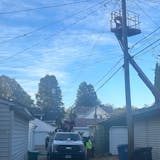Minnesota health officials have confirmed a ninth case of measles in the Hennepin County outbreak that began last week, and they expect the count to rise as additional lab specimens are tested.
The patients, all children, were not vaccinated. Most of the cases have occurred in the Twin Cities Somali-American community, where vaccination rates have been relatively low.
"Whenever you have an outbreak in unvaccinated kids, measles just has a field day," said Kris Ehresmann, infectious disease division director at the Minnesota Health Department. "That is what is happening here,"
The state's health laboratory is testing additional samples, and Ehresmann said she expects the case count to rise. The outbreak is the state's largest since 2011, when 26 cases were recorded.
In the meantime, public health investigators are interviewing families of the affected children, trying to pin down where they might have been exposed.
State and local health officials are contacting schools, mosques, clinics and child care centers that cater to the Somali-American population to educate them about measles symptoms and the importance of the MMR vaccine, which provides protection against measles, mumps and rubella.
Ehresmann said the latest estimates show that only 42 percent of 2-year old Somali-American children had received their first MMR shot, which most health experts recommend at age 1. A second shot is administered when a child enters kindergarten, and produces highly effective immunity. Statewide, the vaccination rate is 88.5 percent.
Low vaccination rates were a factor in a 2011 measles outbreak, including many Somali-American children. At the time, an anti-vaccine advocate was telling community members that the MMR vaccine caused autism — a view that has been discredited by extensive scientific research.


